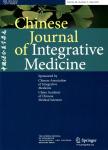Huangqin Decoction Delays Progress of Colitis-Associated Carcinogenesis by Regulating Nrf2/HO-1 Antioxidant Signal Pathwayin Mice
作者机构:Department of Gastrointestinal EndoscopyAffiliated Hospital of Nanjing University of Chinese MedicineNanjing(210029)China Department of GastroenterologyAffiliated Hospital of Integrated Traditional Chinese and Western MedicineNanjing University of Chinese MedicineNanjing(210028)China School of Integrated Chinese and Western MedicineNanjing University of Chinese MedicineNanjing(210023)China
出 版 物:《Chinese Journal of Integrative Medicine》 (中国结合医学杂志(英文版))
年 卷 期:2024年第30卷第2期
页 面:135-142页
核心收录:
学科分类:1006[医学-中西医结合] 1002[医学-临床医学] 10[医学] 100602[医学-中西医结合临床]
基 金:Supported by the Natural Science Foundation Project of Nanjing University of Traditional Chinese Medicine(No.XZR2020030) Jiangsu Famous Traditional Chinese Medicine Inheritance Studio Project(Jiangsu Traditional Chinese Medicine Science and Education(No.20SGzs003)。
主 题:Huangqin Decoction colitis-associated carcinogenesis nuclear factor erythroid 2 related-factor 2/heme oxygenase signaling pathway oxidative stress Chinese medicine
摘 要:Objective:To investigate the effect of Huangqin Decoction(HQD)on nuclear factor erythroid 2 related-factor 2(Nrf2)/heme oxygenase(HO-1)signaling pathway by inducing the colitis-associated carcinogenesis(CAC)model mice with azoxymethane(AOM)/dextran sodium sulfate(DSS).Methods:The chemical components of HQD were analyzed by liquid chromatography-quadrupole-time-of-flight mass spectrometry(LC-Q-TOF-MS/MS)to determine the molecular constituents of HQD.Totally 48 C57BL/6J mice were randomly divided into 6 groups by a random number table,including control,model(AOM/DSS),mesalazine(MS),low-,medium-,and high-dose HQD(HQD-L,HQD-M,and HQD-H)groups,8 mice in each group.Except for the control group,the mice in the other groups were intraperitoneally injected with AOM(10 mg/kg)and administrated with 2.5%DSS orally for 1 week every two weeks(totally 3 rounds of DSS)to construct a colitis-associated carcinogenesis mouse model.The mice in the HQD-L,HQD-M and HQD-H groups were given HQD by gavage at doses of 2.925,5.85,and 11.7 g/kg,respectively;the mice in the MS group was given a suspension of MS at a dose of 0.043 g/kg(totally 11 weeks).The serum levels of malondialdehyde(MDA)and superoxide dismutase(SOD)were measured by enzyme-linked immunosorbent assay.The mRNA and protein expression levels of Nrf2,HO-1,and inhibitory KELCH like ECH-related protein 1(Keap1)in colon tissue were detected by quantitative real-time PCR,immunohistochemistry,and Westem blot,respectively.Results:LC-Q-TOF-MS/MS analysis revealed that the chemical constituents of HQD include baicalin,paeoniflorin,and glycyrrhizic acid.Compared to the control group,significantly higher MDA levels and lower SOD levels were observed in the model group(P0.05),whereas the expressions of Nrf2 and HO-1 were significantly decreased,and the expression of Keap1 increased(P0.01).Compared with the model group,serum MDA level was decreased and SOD level was increased in the HQD-M,HQD-H and MS groups(P0.05).Higher expressions of Nrf2 and HO-1 were observed in the HQD groups.Conclusion:HQD may regulate the expression of Nrf2 and HO-1 in colon tissue,reduce the expression of MDA and increase the expression of SOD in serum,thus delaying the progress of CAC in AOM/DSS mice.



